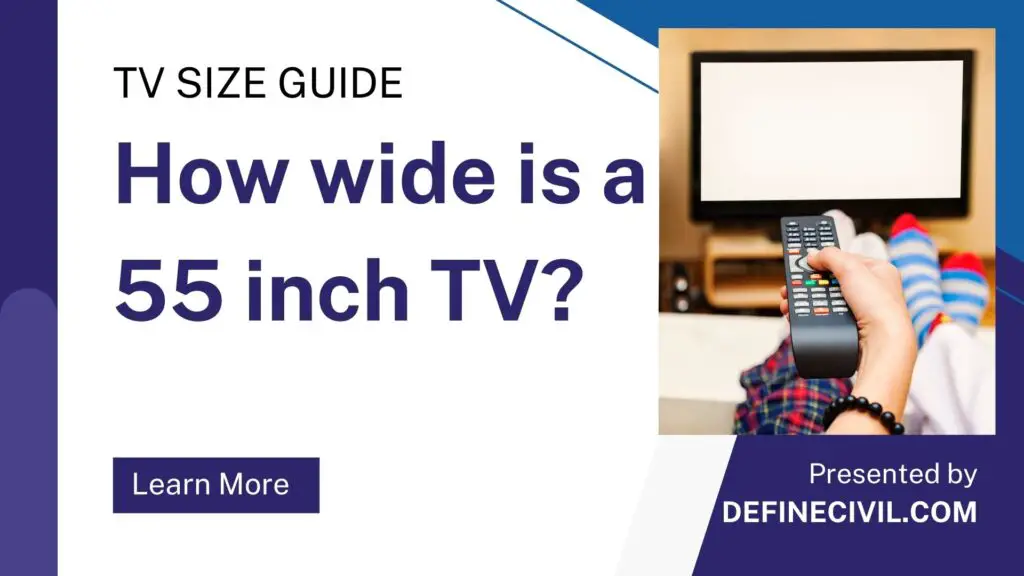So, while seeing different sizes of TV in market, you read 55 inch and are now wondering – How wide is a 55 inch TV?
You might already know that the manufacturers specify the size of TV by taking into account the diagonal of the screen. Anyhow, knowing your TV width and height is a critical factor. You need to choose the right size that blends well with the size of your room.
Size is one of the significant and appealing factor people consider while selecting a TV. Most people are usually not aware of the fact that the size specified by manufacturer is quite different from real size when actually measured.
The point here is that the size given in description is based on the diagonal length of screen exclusive of bezel.
In this article you will get to know how wide is a 55 inch TV in terms of height and width so that next time you walk in a store you are aware of actual dimensions.
Keep bearing with us to enhance your knowledge on the subject.

Table of Contents
- Dimensions of a 55 inch TV
- Height and Width of a 55 inch TV
- Optimum Viewing Distance
- Features Available with a 55″ TV
Dimensions of a 55 inch TV
The size of a TV is dependent on various factors especially with respect to customer’s perspective. The size of room, estimated use, space available, user’s comfort, viewing distance, and few other factors play a vital role in selecting a specific TV size.
To many users it may strike them with surprise that a 55 inch TV falls under medium sized TVs. As mentioned earlier, there always exists a difference between actual size and manufacturer’s specified TV size.
However, over the years TV sizes have been increasing and therefore spiraling back those sizes once considered large under the umbrella of medium sized ones. People, these days, having capacious rooms will likely buy a TV having size greater than 55 inch TV.
The actual dimensions of a 55 inch TV can be calculated using different formulae available on the internet. While using these formulae our main goal is to find the height and width of the screen. One considerable point here is that you have only diagonal length to start your calculations.
Also Read: How to Turn On TV without Remote Control?
This necessitates the need to use some basic mathematics principles to calculate width and height of the screen. You also need to know the aspect ratio of screen. Aspect ratio is simply the ratio of width to height of a display. Usually, you do not have to use any formula to find aspect ratio as you can simply search it online for different screen sizes.
All TVs today have an aspect ratio of 16:9. Technically, it means if the width of a screen is divided into 16 equal parts, the height of that screen is 9 parts.
Height and Width of a 55 inch TV
Rather than diving into complex formulae there is a simple and reliable technique to determine the height and width of a TV display. All you have to do is take around 87% of the diagonal length i.e. 55 inch to determine the width of screen and 49% of 55 inch to calculate the height of display.
To simplify, just multiply 55 inch with 0.87 to find width and with 0.49 to get height. This yields a width of 48 inch and a height of 27 inch. These calculations will give you a handsome idea of actual size and will make it easier for you to purchase a TV according to your requirements. Though these calculations are not on the dot, but are certainly reliable.
Using similar criteria, you can calculate actual dimensions of other display sizes as well. For example, to get width and height of an 85″ TV, we will multiply 85 by 0.87 and 0.49 to calculate width and height respectively. This comes out to be 74″ in width and 41.6″ in height. So next time you are going to buy a TV you will be well aware of these calculations and can choose accordingly.
Optimum Viewing Distance
The distance between the viewer and the TV screen is simply called viewing distance. There are few factors which govern this distance such as size of screen, image resolution, viewing environment, type of screen, range, and field of view. As far as size of screen is concerned it incorporates display resolution too.
In simple words, the screen size and quality of display together determine suitable viewing distance. For a traditional 1080p TV, the viewing distance varies according to size of screen too.
In case of a 55″ inch TV, the viewing distance should be in the range of 7 to 12 feet. For an 85″ TV, the viewing distance should be between 10 and 18 feet. Whatever be the size of your screen and image quality, you can find recommended viewing distance online and enjoy your show accordingly.
For 4K Ultra HD TVs, you can reduce your viewing distance without straining your eyes. For a 55″ TV with 4K resolution, the recommended viewing distance is between 5 and 8 feet. As mentioned earlier, you can find optimal viewing distance according to your TV size and image quality online.
In terms of watching television, field of view is defined as the viewing angle between a person and the visible area of display. The closer you get to the screen, the wider is your field of view and the more enveloping is your viewing experience. Experts recommend a field of view of around 30°. However, you may go slightly above or below this value according to your comfort.
Also Read: how to connect two bluetooth speakers to one tv
Features Available with a 55″ TV
There are many handy features that come with a 55″ TV. Users always have the penchant to modify their viewing experience according to their demand and budget. Certain features that a 55″ TV comes usually equipped with are smart TV function, 4K resolution, and image enhancing tools. Other features are also available depending on the brand you are buying. Therefore, it depends on interest and budget of the user to choose accordingly.

















